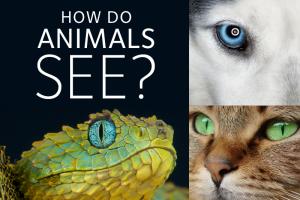
It’s easy to assume we see the world just as it is. But this is just one version of reality based on our limited senses. Animals see many other different versions of the world. Depending on how an animal lives and gets food determines how a particular animal’s eyesight would have evolved over time–many of these ways of seeing we can only imagine or simulate. The following are just some of the methods by which animals “see”:
Rod and cone variation
We humans spend our waking hours during the day, so our eyesight lets us see thousands of brilliant colors in the visual light spectrum. But some animals such as cats are nocturnal therefore good night vision is essential. Therefore, they have many more rods enhancing their ability to see in dim light but fewer cones because color is less important for them.
Resolution
Human vision is among the sharpest of all animals as we have densely packed cones at the center of our retinas. Most animals have blurrier daytime vision as their other senses are superior to ours–especially the sense of smell. Prey birds would be an exception as they can see with about 2.5 times the resolution that we do.
Echolocation
Even though echolocation involves sound, it is how some animals “see” what’s before them. Echolocating animals include whales and dolphins, shrews, some birds and, most notably, bats. Bats use echolocation to locate and catch their prey. As they fly, they produce a constant stream of high-pitched sounds only audible to the bats themselves. When the sound waves produced by these sounds hit an insect, the echoes bounce back and guide them straight to it. Bats also see with polarized light.
Polarized light
Polarized light waves are parallel to each other and vibrate in a single plane. They can be harmful to our eyes, which are why some sunglasses protect against them, but animals use this light in various ways. Cuttlefish produce polarization patterns on their skin which scientists suspect is used for communication. Some bats use polarized light to navigate.
Tapetum lucidum
Have you ever looked at a cat at night and seen its eyes flare green? This is called the tapetum lucidum and it is a reflective layer many animals have behind the retina that sends light that passes through the retina back into the eye to improve night vision. This helps give cats a minimum light detection threshold up to seven times lower than that of humans.
Infrared light
Some snakes can see in two different ways–color and infrared with the infrared sensors located on the head. These tiny sensors are at least 10 times more sensitive than the best artificial infrared sensors humans have been able to build.
Ultraviolet light
On the other side of the spectrum from infrared light is ultraviolet light. Bees use this light to see patterns on flowers indicating the plant’s pollen and nectar amounts. Birds also see ultraviolet in addition to visual light. They are “tetrachromats” which means they have four types of cones to see–red, green, blue, and UV light.
Peripheral vision
Some animals such as your pet dog or cat have much wider peripheral vision. Cats have a 200 degree visual field as opposed to 180 degrees in humans.
It’s fascinating to imagine how much more to the world there is than what we can see with our human eyes. By studying animals and what they can see, we get a glimpse at the larger picture.





